Begonias are popular outdoor plants, and they’re commonly grown in window boxes and porch planters too. But if you want to enjoy stunning begonia plants year-round, growing begonias as houseplants is the way to go! Many begonia plants thrive in indoor setups, and when properly cared for, begonias can be some of the most strikingly colored plants that you can find.
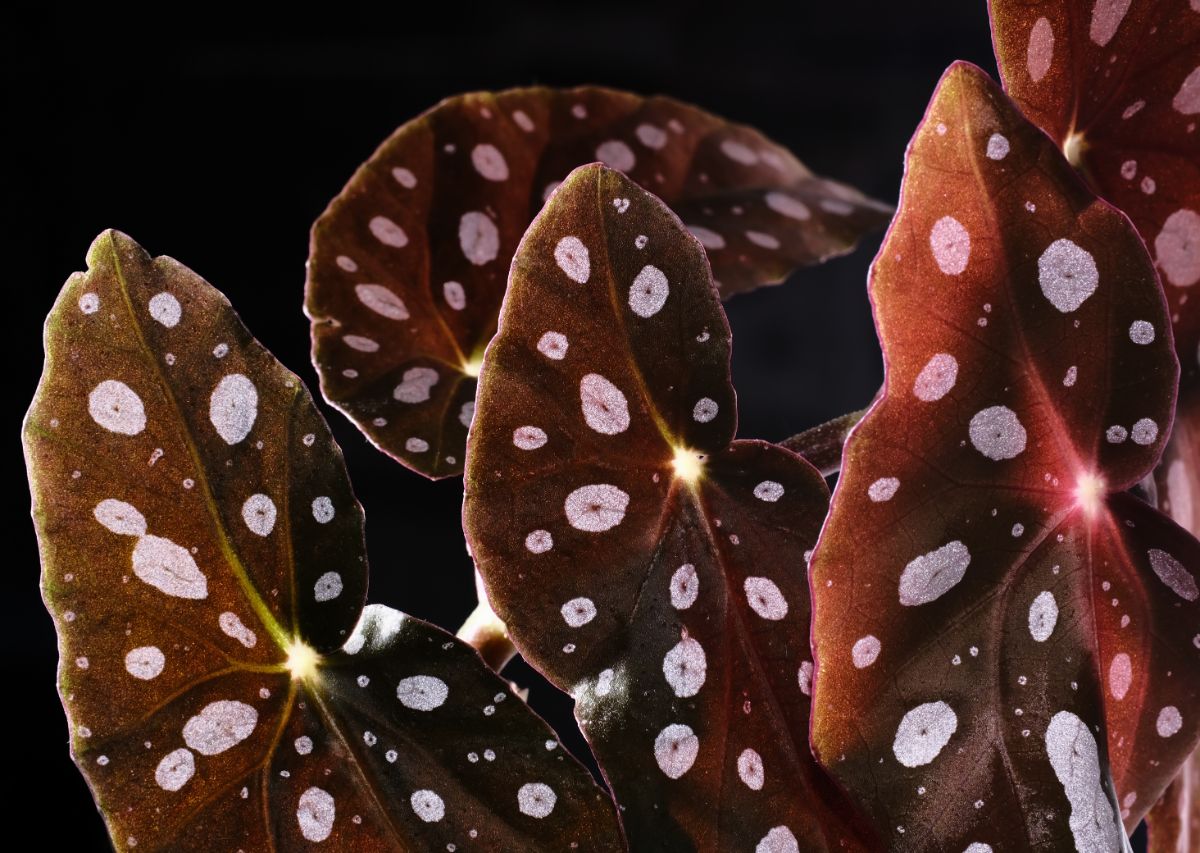
Most begonia plants are kept as foliage plants, and begonias, in general, are famed for their showy and brilliantly colored leaves. However, many begonia plants bloom well indoors, too, and some begonia varieties can even flower in mid-winter! If you’re ready to find the best begonia variety to grow in your home, read on and discover some of our favorite begonia choices.
Jump to:
- 18 showy begonia varieties to grow as houseplants
- 1. Polka dot begonia (Begonia maculata ‘Wightii’)
- 2. Begonia ‘Gryphon’
- 3. Begonia ‘Pink Minx’
- 4. Begonia Melanobullata
- 5. Begonia ‘Fireworks’
- 6. Begonia ‘Maurice Amey’
- 7. Begonia ‘Escargot’
- 8. Begonia ‘Lucerna’
- 9. Begonia Amphioxus
- 10. Begonia Pavonina
- 11. Begonia Soli-Mutata
- 12. Begonia ‘Erythrophylla’
- 13. Begonia ‘Marmaduke’
- 14. Begonia Ferox
- 15. Begonia Luxurians
- 16. Begonia Kingiana
- 17. Begonia Brevirimosa
- 18. Strawberry begonia (Saxifraga stolonifera)
- Frequently asked questions
- Summary
18 showy begonia varieties to grow as houseplants
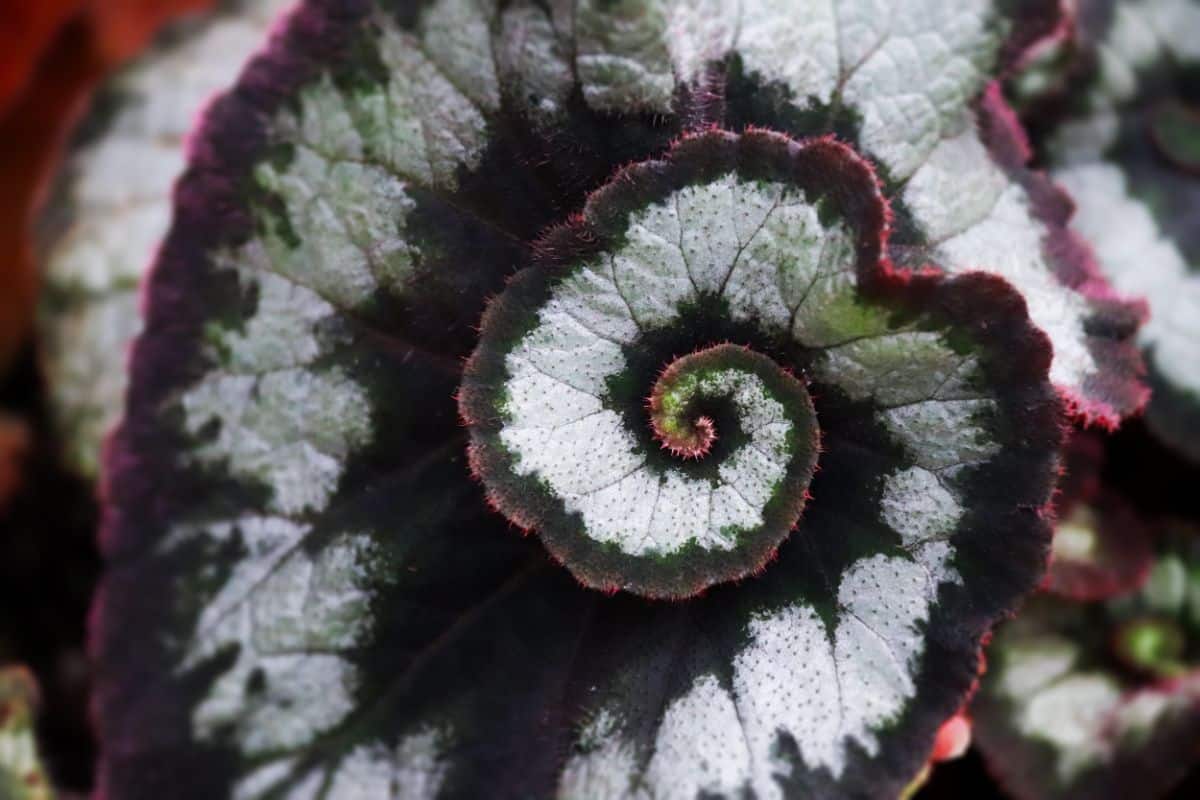
The begonia family is a large one, and today, there are over 1800 different begonia species and hybrids to choose from. Given all of that variety, we can’t cover all types of begonias in this quick guide, but our selections contain easy-to-grow plants and particularly showy specimens. Some begonias are better for growing outdoors than others, but the begonias listed below all thrive in indoor setups!
1. Polka dot begonia (Begonia maculata ‘Wightii’)
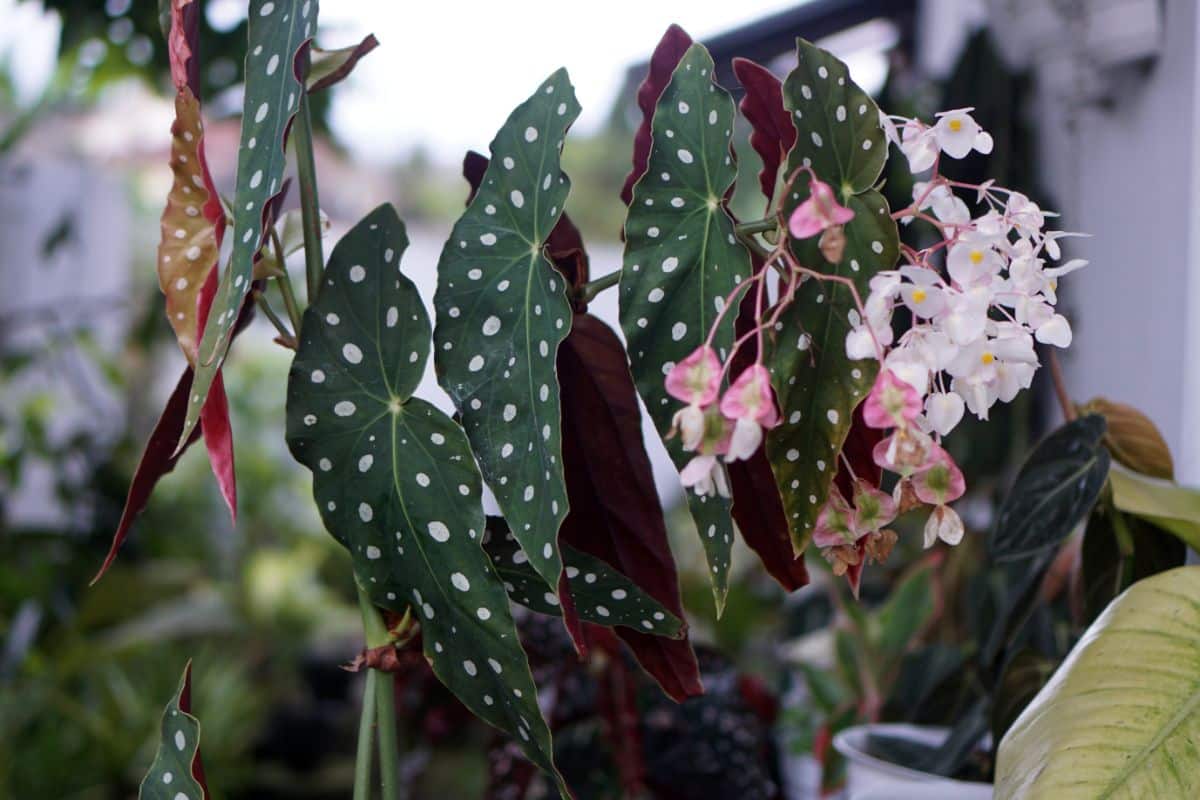
| Plant name: | Polka dot begonia |
| Light requirements: | Bright, indirect light |
| Water requirements: | Moderate |
| Begonia type: | Cane |
The gorgeous polka dot begonia gets its playful name from its silver spots, which are splattered across the plant’s large leaves. But these plants aren’t just known for their leaf patterns. Polka dot begonias also have showy, rust-red coloration on the undersides of their leaves, which makes the plant look appealing from any angle.
A variety of cane begonia, polka dot begonias are quite easy to grow indoors with a little light, water, humidity, and the occasional pruning. When these plants are happy, they will reliably flower indoors -- producing small, white flowers from spring through mid-summer.
Like many begonias, polka dot begonias prefer dappled sunlight, and they can develop brown spots on their leaves if they’re grown in full sun.
2. Begonia ‘Gryphon’
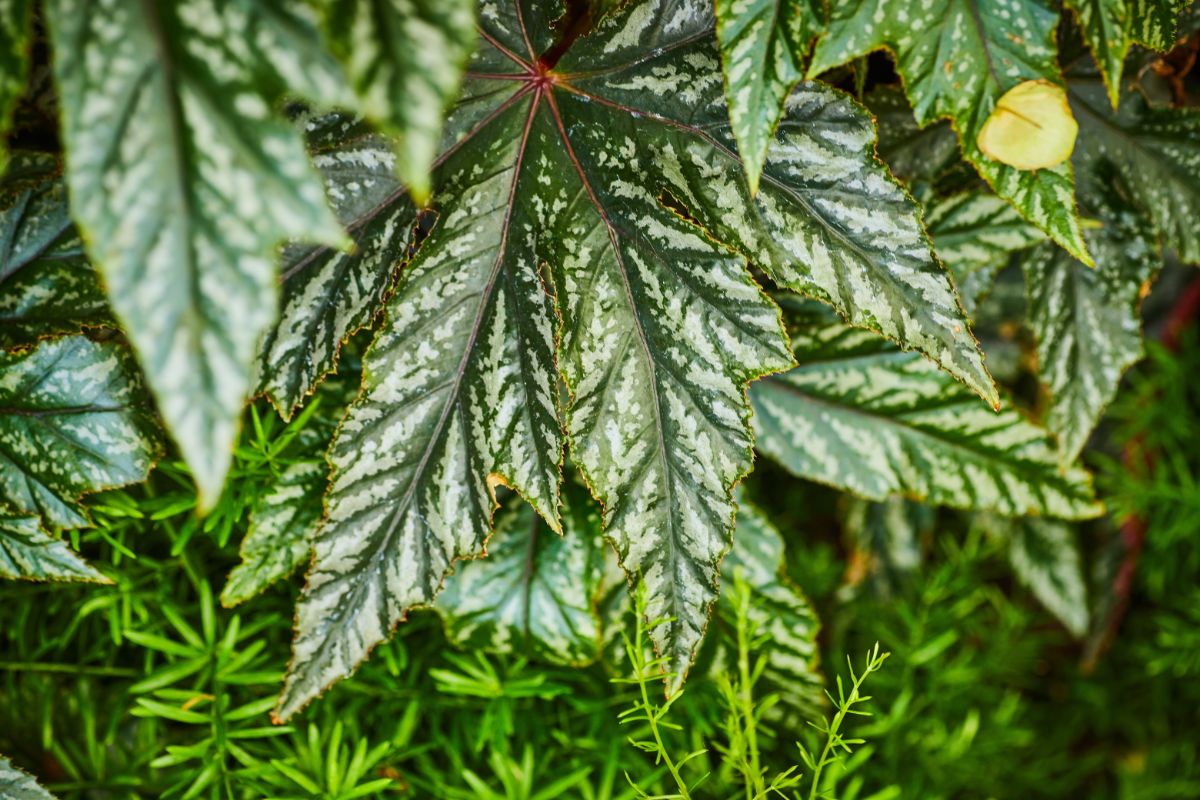
| Plant name: | Begonia ‘Gryphon’ |
| Light requirements: | Bright, indirect light |
| Water requirements: | Moderate |
| Begonia type: | Cane |
An excellent choice for beginners, the ‘Gryphon’ begonia has deep green, shaggy leaves that give the plant a tropical vibe. Like other cane begonia plants, ‘Gryphon’ begonias grow upright, and they have robust, bamboo-like, herbaceous stems that give the plant a lot of vertical interest. However, like many other begonias, ‘Gryphon’ begonias prefer part shade, so you’ll want to think carefully about where you locate your plant in your home.
Often, ‘Gryphon’ begonias will grow best in an east- or west-facing window, which will provide the plant with either morning or late afternoon sunlight. As with polka dot begonias, ‘Gryphon’ begonias can suffer from sun scorching in too much light, but adding a sheer curtain to bright windows can also help to protect your plant’s delicate leaves. ‘Gryphon’ begonias thrive with regular moisture, but the soil should be allowed to dry out a bit in between waterings.
3. Begonia ‘Pink Minx’
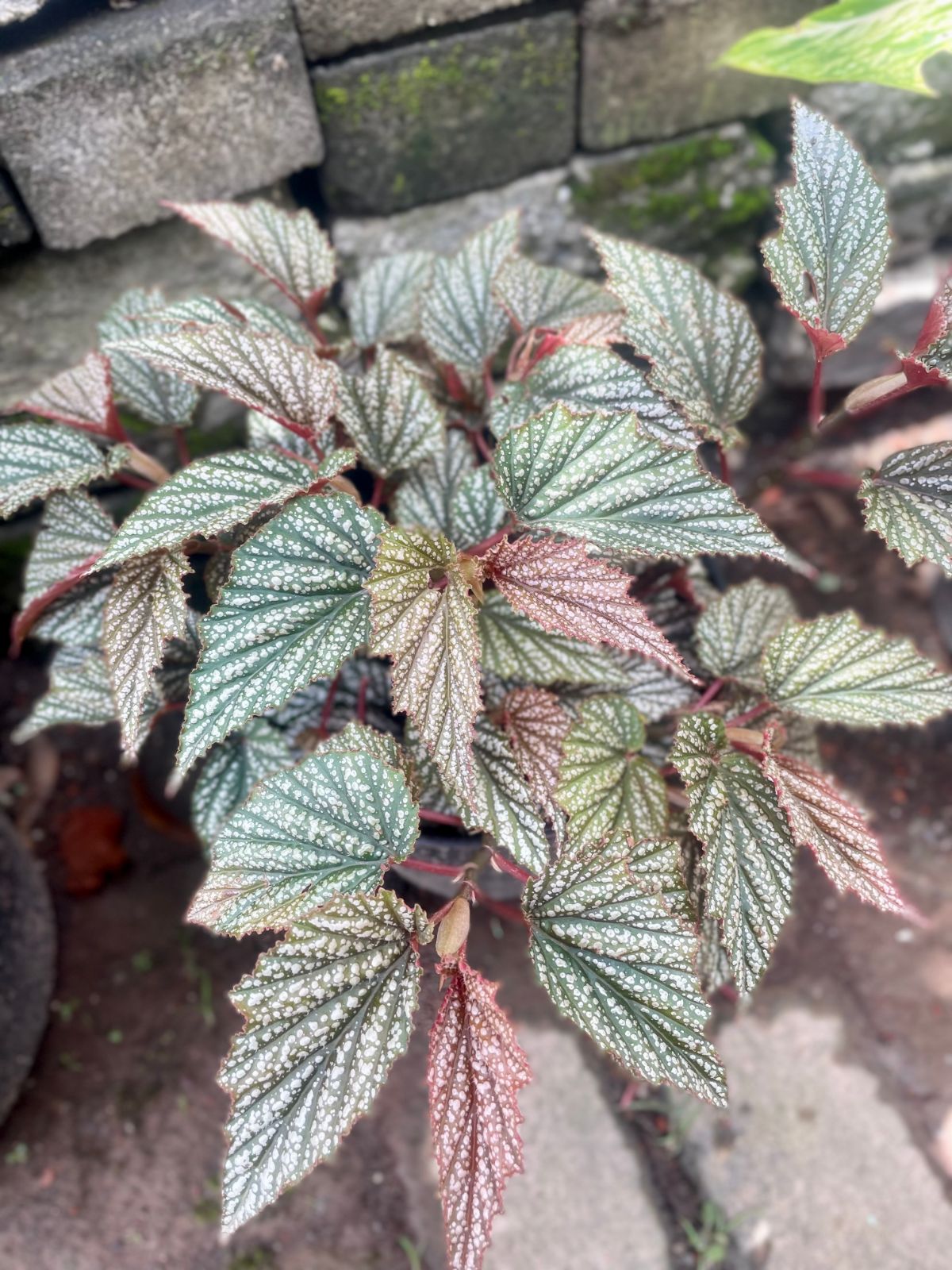
| Plant name: | Begonia ‘Pink Minx’ |
| Light requirements: | Bright, indirect light |
| Water requirements: | Moderate |
| Begonia type: | Cane |
The ‘Pink Minx’ begonia is a saucy cane begonia that’s sure to add a pop of color to any home. This plant’s dark green leaves are adorned with splashes and blotches of silvery pink, which creates a striking contrast. For fuller growth and more branching, try pinching off the growing tips of this begonia plant while it’s still in its early stages.
Compared to some other begonia types, the ‘Pink Minx’ can be a bit finicky as it prefers higher humidity levels than some other cane-type begonias. However, you can usually maintain the look and feel of these plants by mimicking the environment they prefer and keeping a humidifier nearby. Mature plants typically grow to about 12 to 18” in height, and they should be watered whenever the top 2” of soil feels dry to the touch.
4. Begonia Melanobullata
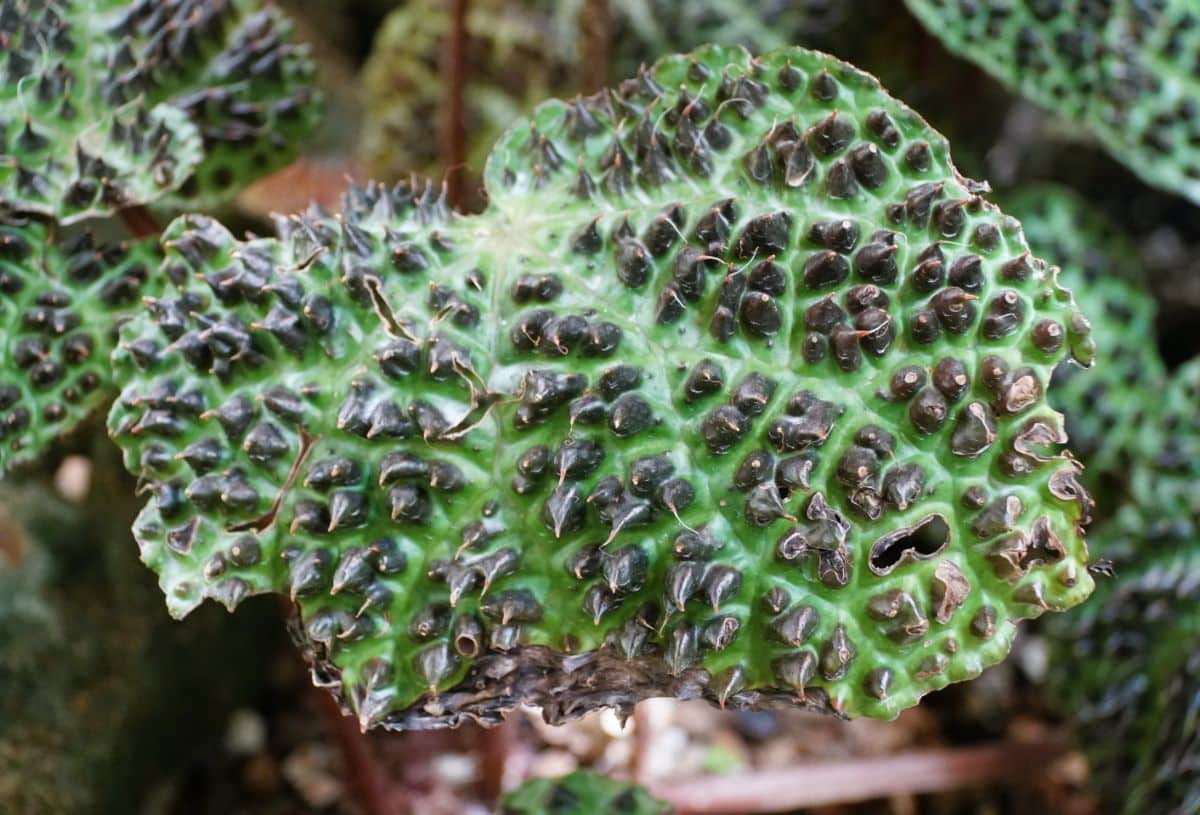
| Plant name: | Begonia Melanobullata |
| Light requirements: | Bright, indirect light |
| Water requirements: | Moderate |
| Begonia type: | Rhizomatous |
Begonia melanobullata is a relatively rare, rhizomatous begonia that may be hard to find. But if you love begonias, this plant is definitely worth looking for, and you can often locate cuttings or plants for sale online. Originating in Vietnam, this begonia variety has a very distinct and textured look with bright green leaves that are ornamented with curious, dark spikes.
But while begonia melanobullata is certainly attractive, this plant also displays a fascinating, chameleon-like quality. When backlit by the sun, begonia melanobullata undergoes a dramatic transformation, and its leaves display vibrant red and yellow coloration… almost like stained glass! These plants tend to grow best in east or south-facing windows or other areas with bright, indirect light, and they should be watered when the soil feels dry.
5. Begonia ‘Fireworks’
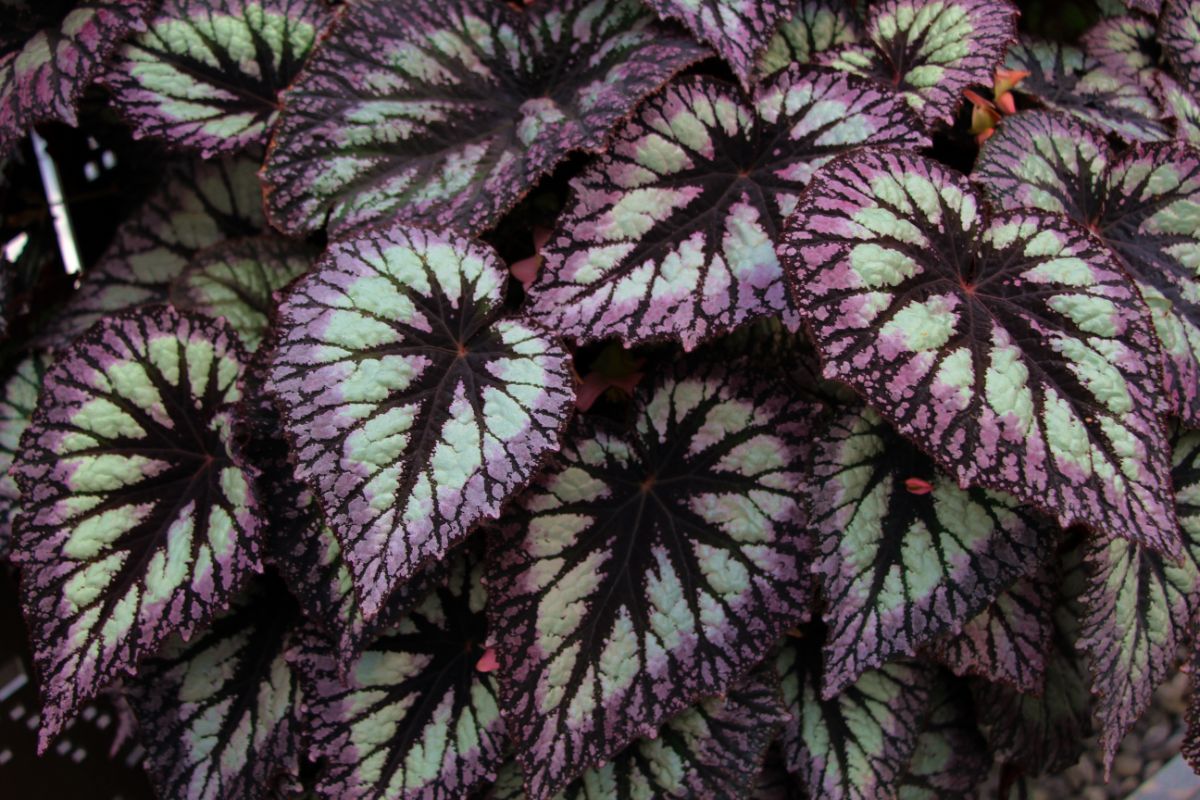
| Plant name: | Begonia ‘Fireworks’ |
| Light requirements: | Bright, indirect light |
| Water requirements: | Moderate |
| Begonia type: | Rhizomatous |
As its name suggests, the ‘Fireworks’ begonia is a showy plant with lots of vibrant colors. This exquisite, rex-type begonia features silvery green leaves that seem to “explode” like fireworks into rich shades of lavender and deep, dark purple. Plus, these plants generally grow only 10 to 16” tall, which makes them a good choice for small houseplant collections or tabletop displays!
Taking care of a ‘Fireworks’ begonia plant is relatively straightforward. Just make sure your plant is located in a spot that receives bright, indirect light, and water your plant when the soil feels dry to the touch. To keep your plant looking trim and tidy, remove dead leaves from time to time and make sure your plant is growing in rich, organic, and well-draining soil.
6. Begonia ‘Maurice Amey’
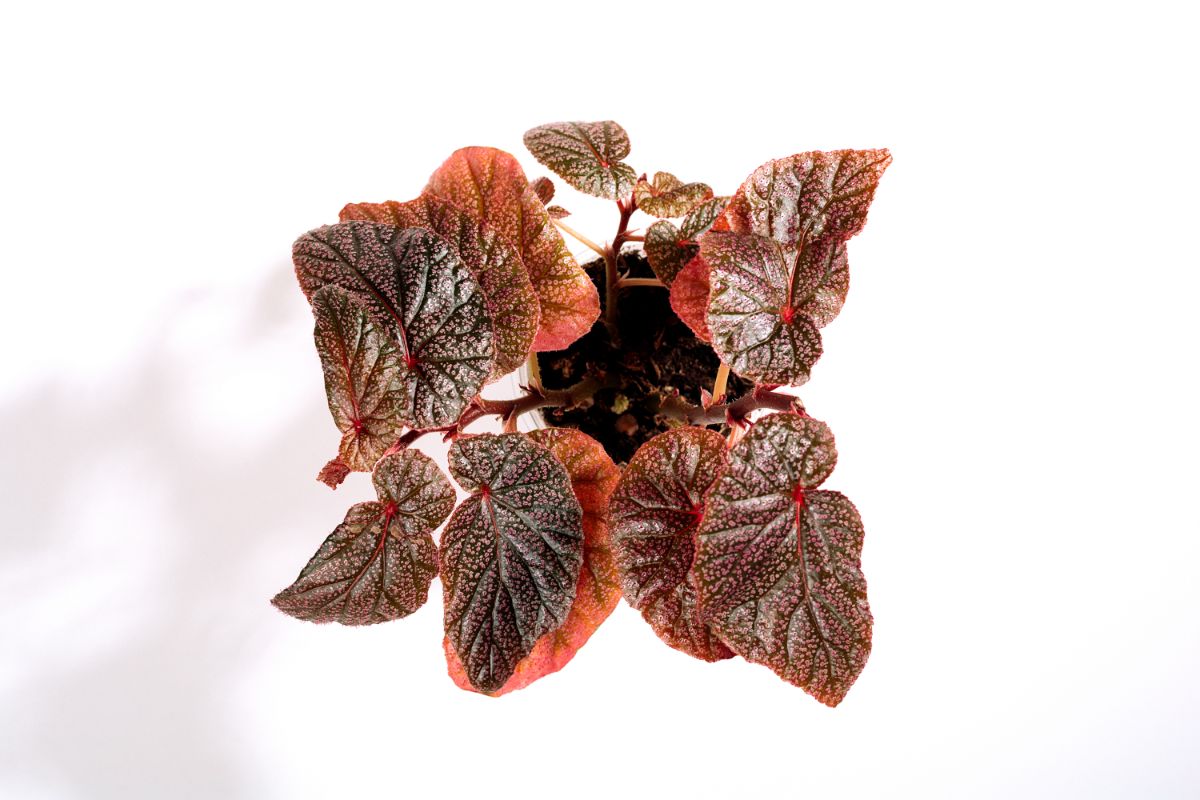
| Plant name: | Begonia ‘Maurice Amey’ |
| Light requirements: | Bright, indirect light |
| Water requirements: | Moderate |
| Begonia type: | Cane |
Another striking begonia option for color lovers, the ‘Maurice Amey’ boasts large, metallic-pink leaves adorned with small, silvery spots. A top pick for livening up drab living rooms and bedrooms, this begonia plant is a relatively fast grower, and it also blooms reliably indoors! Mature plants typically produce their vibrant pink flowers from spring to summer, but they can sometimes continue to flower into fall.
If you’re new to growing cane begonias, ‘Maurice Amey’ can be a perfect, beginner-friendly begonia to try. Fairly easy to take care of, this begonia thrives in bright, indirect light, and it grows well at standard room temperatures. Typically, these plants only need to be watered every 7 to 10 days, but you’ll know it’s time to get out your watering can when the top 2” of your plant’s soil feels dry.
7. Begonia ‘Escargot’
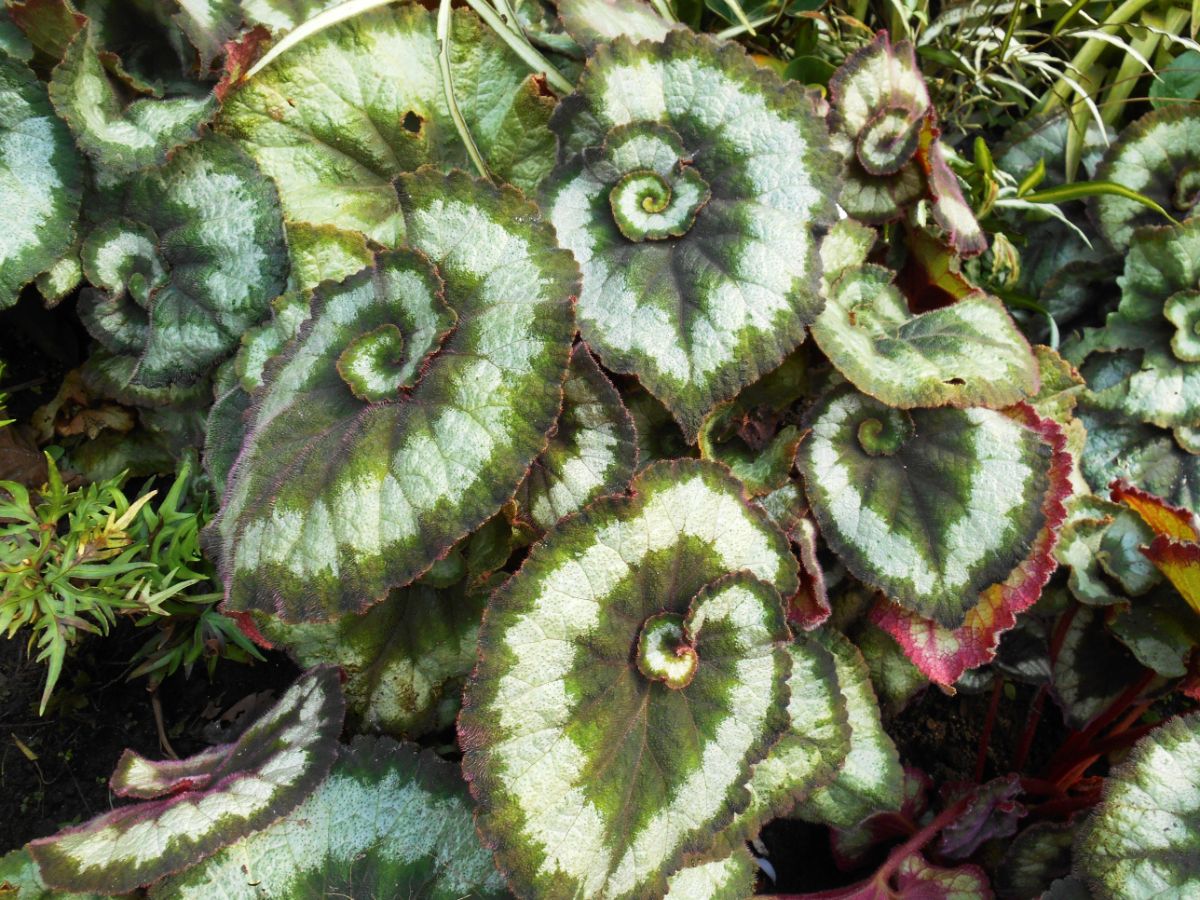
| Plant name: | Begonia ‘Escargot’ |
| Light requirements: | Bright, indirect light |
| Water requirements: | Moderate |
| Begonia type: | Rhizomatous |
The aptly named ‘Escargot’ begonia is a fun plant to try if you love whimsical shapes and plants that stand out. The leaves on this begonia plant have a spiral design that’s reminiscent of a snail’s shell, and it makes a fine complement to polka dot begonias and other plants with bold leaf patterns. Like other rex-type begonias, ‘Escargot’ begonias are also sometimes known as “painted leaf” begonias, and they are commonly sold at plant nurseries.
While ‘Escargot’ begonias can flower indoors, blooms are relatively inconspicuous, and these plants are mostly kept for their unusual leaves. Like most other begonias, ‘Escargot’ begonias grow best in dappled sunlight, and they’re well suited for growing in east-facing windows or under a grow light. In hot and dry climates, ‘Escargot’ begonia plants should usually be watered about once a week, but these houseplants will need less water in winter.
8. Begonia ‘Lucerna’
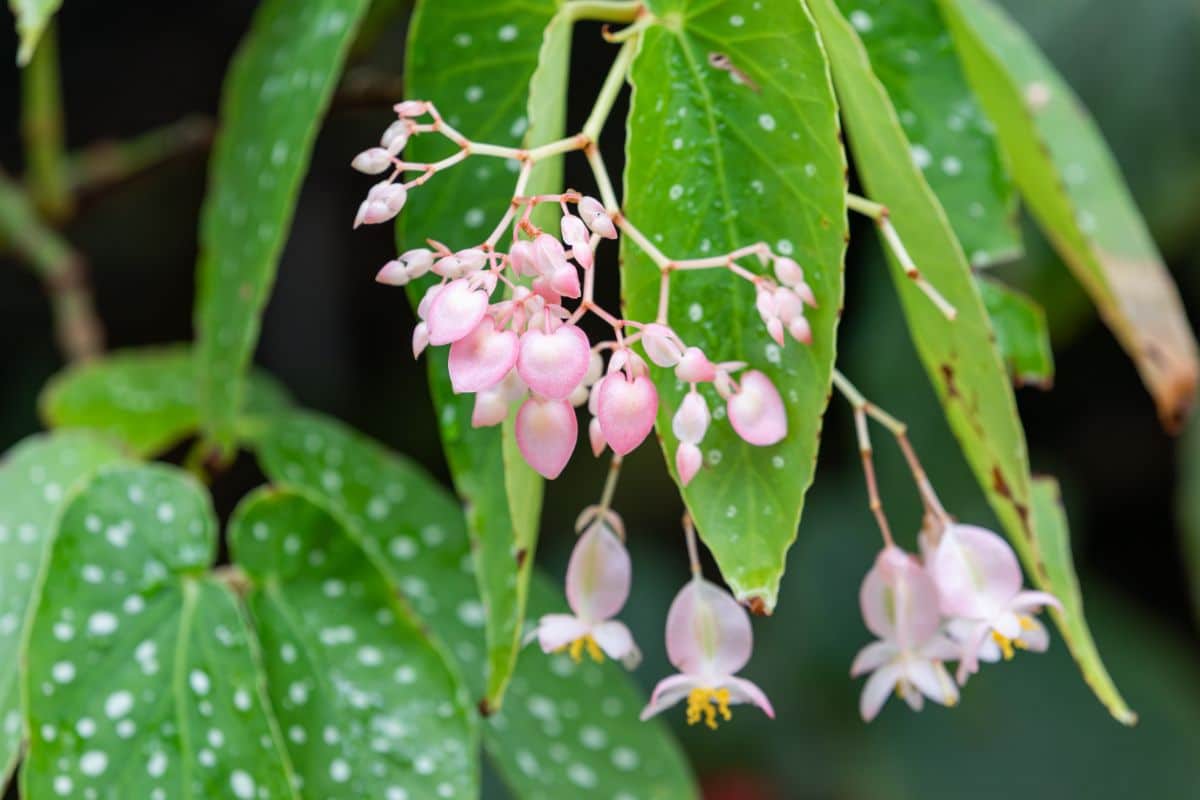
| Plant name: | Begonia ‘Lucerna’ |
| Light requirements: | Bright, indirect light |
| Water requirements: | Moderate |
| Begonia type: | Cane |
A classic, angel wing-type begonia, ‘Lucerna’ is a darling of a plant with big, green, glossy leaves and eye-catching pink flowers that can’t help but melt your heart. Named for Lucerne, Switzerland, where the plant was first hybridized in 1892, ‘Lucerna’ begonias can get quite massive, and their sturdy cane stems can reach up to 6 to 8’ tall! But while there’s no doubt that ‘Lucerna’ is a fast grower, this plant can be kept smaller with regular pruning.
Compared to some other begonia types, ‘Lucerna’ is relatively low maintenance, so it’s an excellent choice for new plant parents. Happiest in bright, indirect light, ‘Lucerna’ loves a bit of extra indoor humidity, but these plants can usually handle average indoor humidity levels. And don’t forget, if you prune ‘Lucerna’ (or other cane-type) begonias, save those trimmings because they root easily in water!
9. Begonia Amphioxus

| Plant name: | Begonia Amphioxus |
| Light requirements: | Medium to low light |
| Water requirements: | Moderate |
| Begonia type: | Rhizomatous |
For that showstopping flair that just won’t quit, the begonia amphioxus is hard to beat. This begonia has bewitching, pointed green leaves that are covered in dark red spots for lots of houseplant drama. But what makes this begonia plant really special is its ability to produce small, greenish-white flowers at almost any time of the year!
When it comes to caring for this small, cane-type begonia, keep in mind that begonia amphioxus responds well to rich, well-drained soil. When growing begonia amphioxus indoors, you’ll want to place your plant near a north or east-facing window to shelter the plant’s tender leaves from too much bright sun. Like other begonias, begonia amphioxus should be watered regularly, and it should be fertilized with a liquid, organic fertilizer when the plant is actively growing in spring and summer.
10. Begonia Pavonina
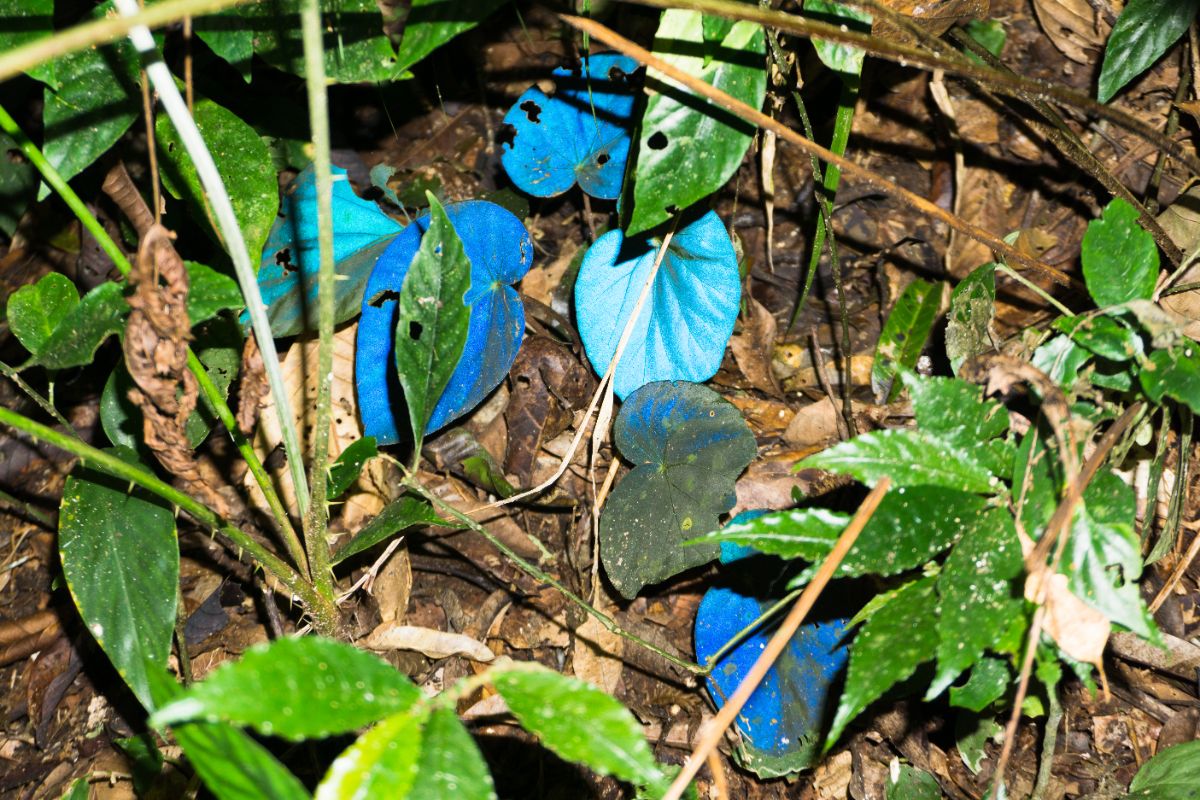
| Plant name: | Begonia Pavonina |
| Light requirements: | Bright, indirect light |
| Water requirements: | Moderate |
| Begonia type: | Rhizomatous |
A true plant lover’s plant, begonia pavonina has all the charm you’ve come to expect from other begonia plants… but with a twist. While this plant has dark green leaves in most lighting, if you shine a light on the pavonina’s leaves from the right angle, the leaves appear to blaze blue! A truly unique feature for a houseplant is that blue coloration is actually the result of pavonina’s natural iridescence, and it’s a rare thing to find in the houseplant world.
Because the begonia pavonina is so rare, you may have trouble locating a specimen for your collection, but these plants can be purchased online. Once you’ve brought begonia pavonina into your home, keep your plant happy by growing it in medium to low light and keeping humidity levels high with a pebble tray or humidifier. In fact, because begonia pavonina craves humidity so much (80% or higher), you may even want to keep this plant in a grow cabinet or terrarium.
11. Begonia Soli-Mutata
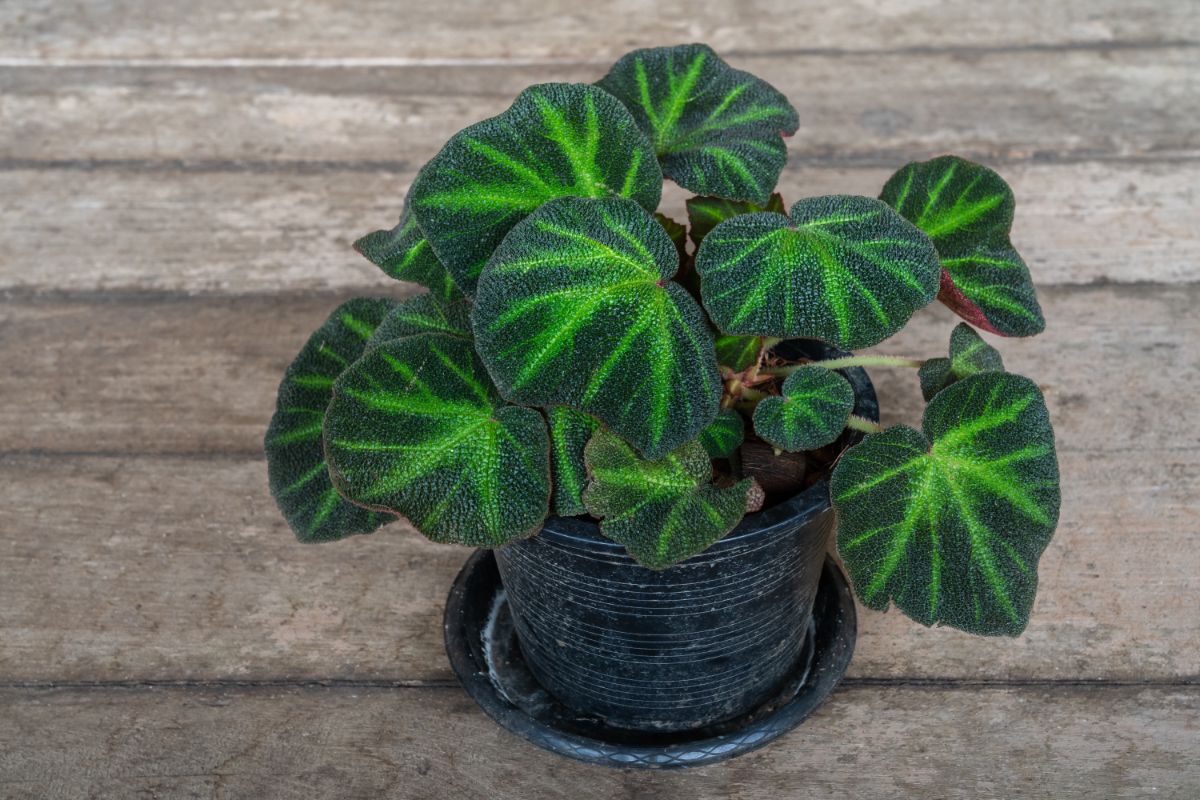
| Plant name: | Begonia Soli-Mutata |
| Light requirements: | Bright, indirect light |
| Water requirements: | Moderate |
| Begonia type: | Rhizomatous |
Begonia soli-mutata is a funky-looking plant with highly textured and patterned leaves that are somewhat reminiscent of begonia melanobullata. But what makes this begonia really exceptional is the fact that its leaves change colors in different lighting. After all, that’s how the plant got its nickname, the “sun changing begonia!”
Soli-mutata’s deep green, oval-shaped leaves are covered in small bumps, but those leaves can look darker or lighter depending on how intense the light is. And for even more interest, soli-mutata’s leaves are also ornamented with steaks of lighter coloration, which slightly resemble bold lightning strikes flaming through the leaf’s surface. When properly care for, this begonia variety will also bloom reliably indoors, although its white flowers are rather small and inconspicuous.
12. Begonia ‘Erythrophylla’
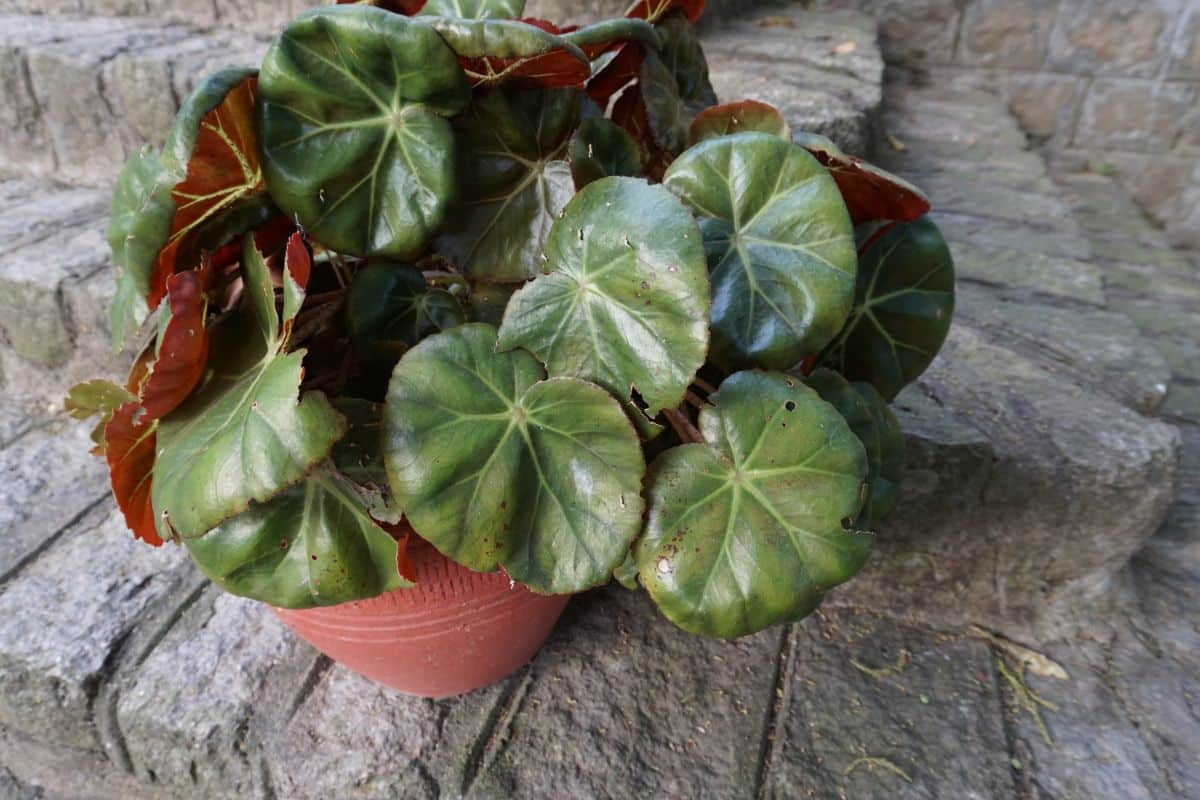
| Plant name: | Begonia ‘Erythrophylla’ |
| Light requirements: | Bright to bright, indirect light |
| Water requirements: | Moderate |
| Begonia type: | Rhizomatous |
Also known as the beefsteak begonia, the begonia erythrophylla is one of the oldest begonia hybrids still in cultivation. This plant’s oval leaves are dark green and glossy, with a pleasingly smooth texture that brings to mind the Chinese money plant. Sometimes grown outdoors, ‘Erythrophylla’ can handle full sun, but it’s also perfectly happy when kept indoors in a window that receives bright, indirect light.
Easy to grow yet rewarding, ‘Erthrophylla’ begonias are a good choice for beginner growers or anyone who just adores the begonia family. These plants aren’t as fussy about humidity as some other begonia plants, but they can grow even better when kept near a humidifier. Like other begonias, ‘Erythrophylla’ needs to be watered regularly, but the soil should dry out a bit between waterings to keep plant roots from getting waterlogged.
13. Begonia ‘Marmaduke’
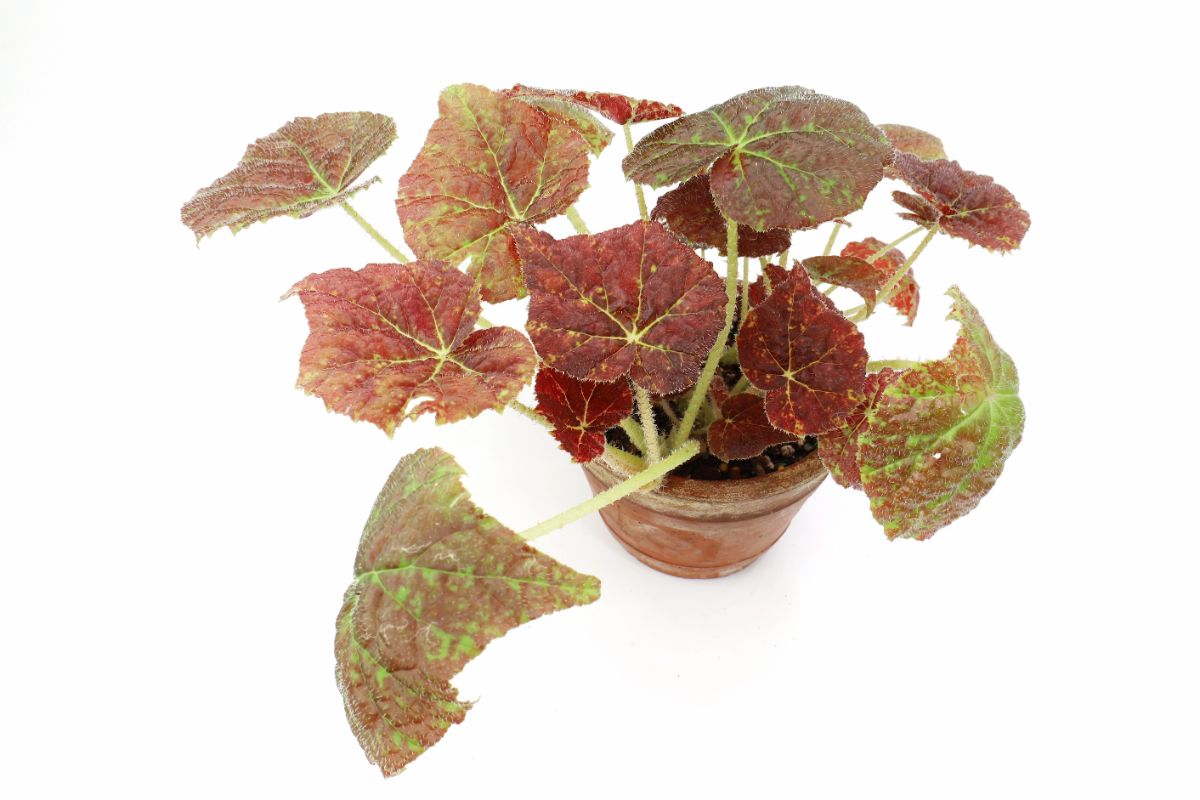
| Plant name: | Begonia ‘Marmaduke’ |
| Light requirements: | Bright, indirect light |
| Water requirements: | Moderate |
| Begonia type: | Rhizomatous |
Another colorful begonia option, ‘Marmaduke,’ has maple-shaped leaves that are a bright neon green with intriguing red flecking. A classic yet striking plant, ‘Marmaduke’ generally maintains a mounded growth habit as it matures, but the plant can benefit from pruning from time to time. With such colorful leaves, ‘Marmaduke’ begonias look becoming when potted up on their own, but they look even more vibrant when kept in a mixed houseplant collection with other flashy begonia cultivars.
If you’ve kept begonias before, ‘Marmaduke’ begonia care should pose no problem at all. These plants have the same basic maintenance requirements that are common to many types of begonias. Keep these plants in bright, indirect sunlight, water them regularly, and shield your plant from chilly drafts, and your ‘Marmaduke’ begonia should reward you with eye-catching foliage all year round.
14. Begonia Ferox
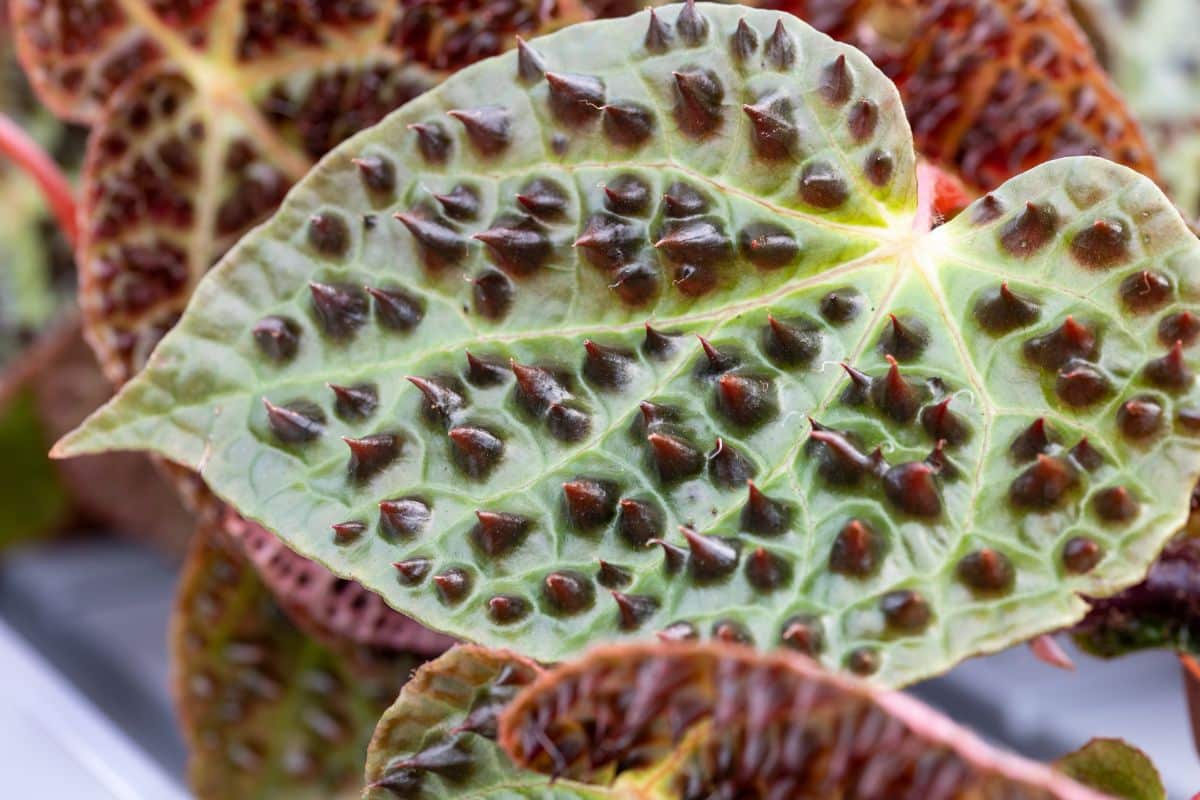
| Plant name: | Begonia Ferox |
| Light requirements: | Bright, indirect light |
| Water requirements: | Moderate |
| Begonia type: | Rhizomatous |
The begonia ferox is a dramatic-looking plant that’s often confused with begonia melanobullata. However, while these two plants both have spiky leaves (those little bumps are known as bullae!), begonia ferox usually doesn’t develop leaf texture until the plant is mature, while begonia melanobullata’s leaves are textured right from the start. In the world of begonias, ferox begonias can be hard to find, but you can sometimes get lucky and locate a plant or cutting online!
While begonia ferox may look fierce with its spiky leaves, those raised cones or bullae aren’t sharp to the touch… although they sure look like they would be! Blooming from mid-winter until spring, begonia ferox can make your home feel like springtime, even when other plants are far from flowering. Plus, this plant is fairly easy to take care of, and it can handle standard indoor humidity levels, although it grows best when humidity levels are around 60%.
15. Begonia Luxurians
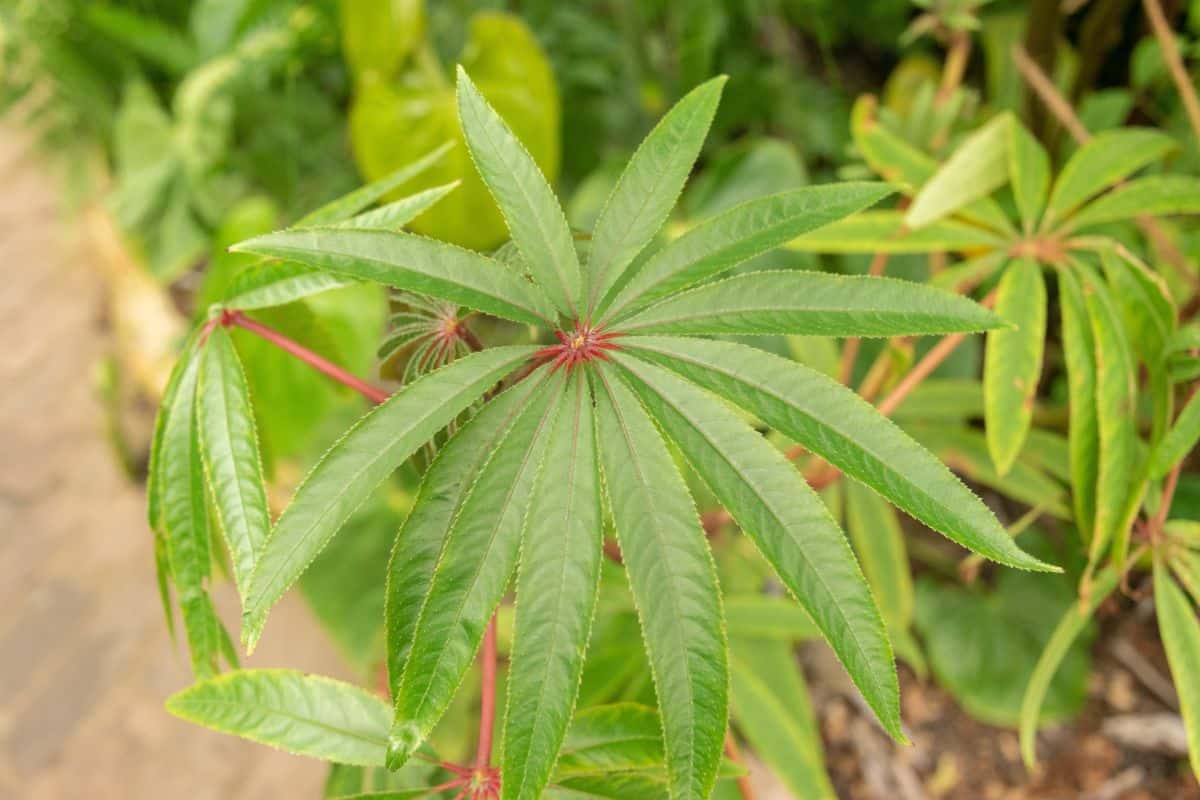
| Plant name: | Begonia Luxurians |
| Light requirements: | Bright, indirect light |
| Water requirements: | Moderate |
| Begonia type: | Cane |
Originating in the rainforests of Brazil, the “palm leaf” begonia or begonia luxurians may look like a tiny palm tree, but it's much easier to grow indoors! This plant's large, hand-shaped leaves are green, but their undersides are a bright, pinkish-purple color that will hold your attention. Even better, palm leaf begonias have purple, cane-like stems for even more color contrast.
Under the right growing conditions, the begonia luxurians is an impressive grower, and mature plants can easily reach 8 to 10' tall; however, you can keep these plants shorter with pruning. If you do choose to let your palm leaf begonias grow wild, it's wise to support their stems with bamboo poles or other sturdy supports so they don't topple over. While these plants can be a bit more tricky for beginning gardeners to manage, palm leaf begonias are still relatively easy to keep as long as you water them regularly and provide them with adequate light.
16. Begonia Kingiana
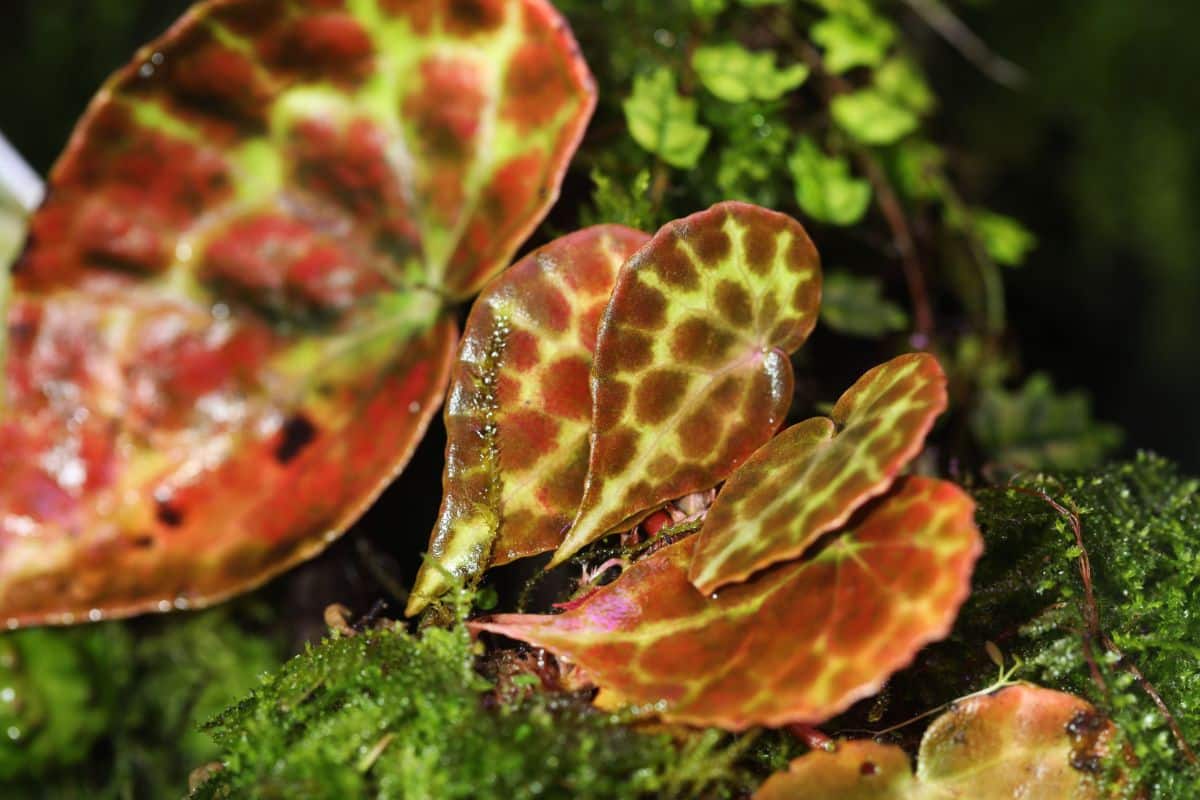
| Plant name: | Begonia Kingiana |
| Light requirements: | Bright, indirect light |
| Water requirements: | Moderate |
| Begonia type: | Rhizomatous |
Sometimes nicknamed the tortoiseshell begonia, begonia kingiana has thick and patterned leaves that are colored in shades of green, purple, and even bronze… much like a tortoise’s shell. However, if you keep a lot of houseplants, you may note that this begonia variety bears some resemblance to the watermelon peperomia. Relatively uncommon in the houseplant world, this begonia type is rarely found in stores, so you’ll probably need to order it online.
Begonia kingiana is native to Malaysia, but it is quite low maintenance when kept as a houseplant. As long as this plant is grown in bright, indirect light and watered regularly, it shouldn’t give you much trouble, although it will grow a bit better with extra humidity. Full-grown plants grow to about 6” high, and they can flower intermittently throughout the year.
17. Begonia Brevirimosa
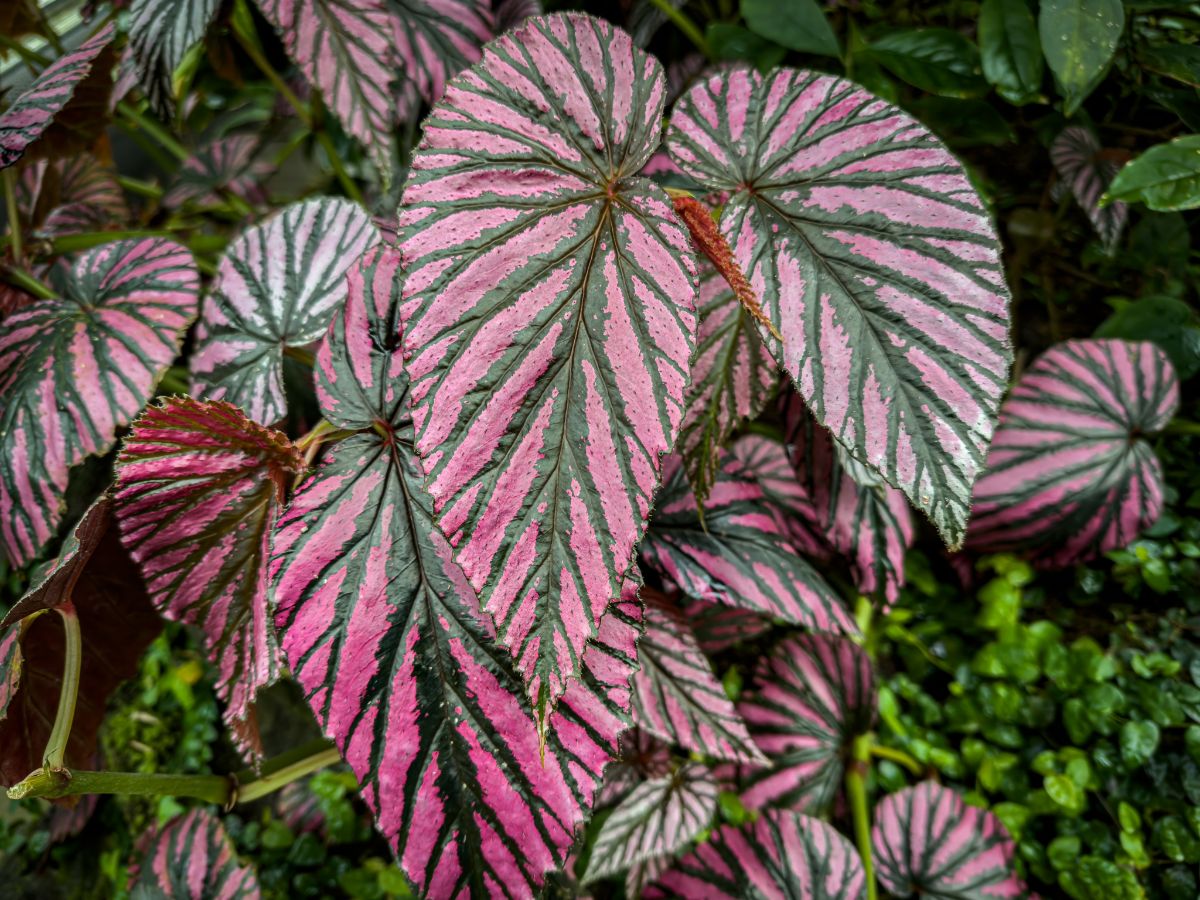
| Plant name: | Begonia Brevirimosa |
| Light requirements: | Bright, indirect light |
| Water requirements: | Moderate |
| Begonia type: | Cane |
The begonia brevirimosa looks out of this world, with elongated, pointed leaves that are adorned with a brilliant green and bright pink coloration. A tall, cane-type begonia, begonia brevirimosa can stretch up to 3’ tall, and it maintains a bushy habit as it matures. Depending on your personal preferences, you can prune brevirimosa begonias during the growing season or allow these plants to grow as is.
Like other cane-type begonias, brevirimosa is easy to propagate from stem cuttings placed either in soil or water, which is great news if you love this plant! Propagating begonias of all sorts is a wonderful way to add more plants to your collection without spending a single cent. Just remember that, like many of the other plants on this list, begonia brevirimosa needs bright, indirect light and weekly waterings to grow well.
18. Strawberry begonia (Saxifraga stolonifera)
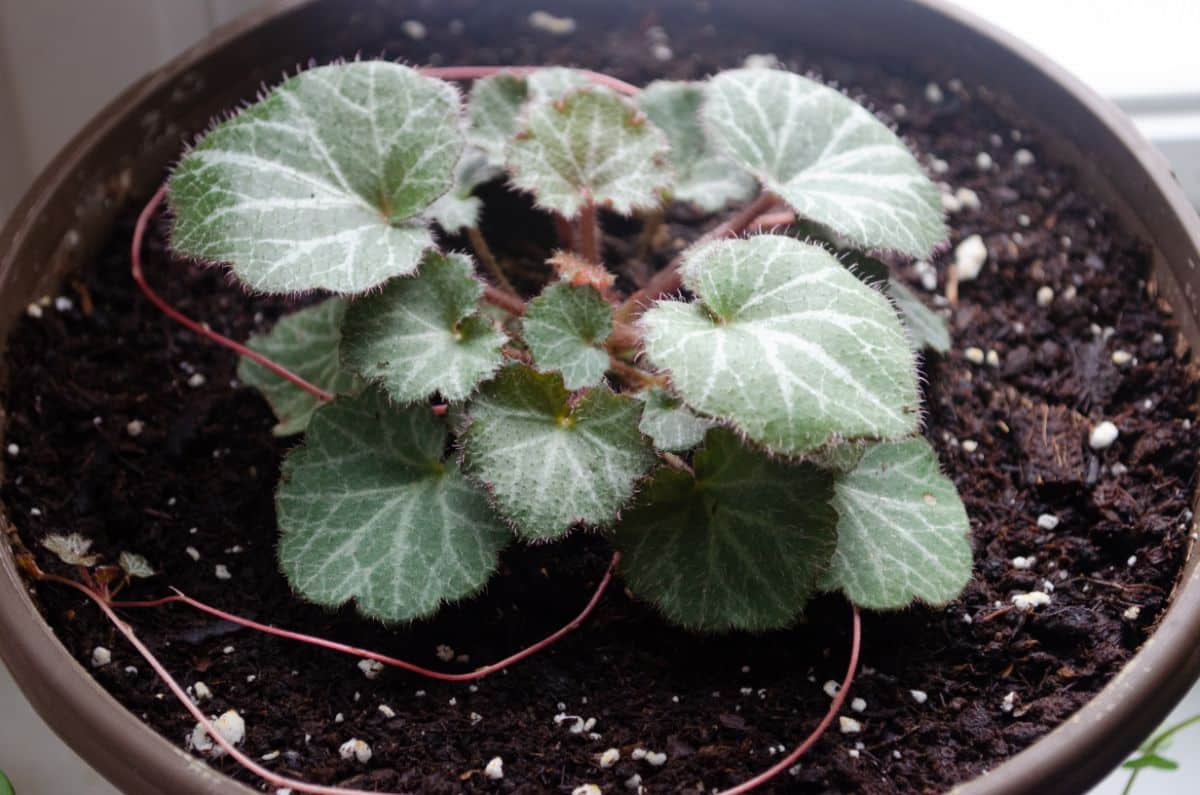
| Plant name: | Strawberry Begonia |
| Light requirements: | Bright, indirect light |
| Water requirements: | High to moderate |
| Begonia type: | N/A |
Despite its name, strawberry begonia isn’t actually a begonia at all, but it does have that begonia-like charm that may make it appealing to begonia lovers. Strawberry begonias are trailing plants that are often grown in hanging baskets thanks to their runners, which are said to look a bit like strawberry runners. However, strawberry begonias aren’t related to strawberries either, and they’re actually close relatives of jades, coral bells, and astilbes.
While strawberry begonias may not be true begonias, these adorable houseplants have a lot to recommend them. In addition to being easy to grow, these plants also add vertical interest to houseplant collections with their trailing runners, and they bloom sweet, white flowers from spring to early summer. Like many true begonias, strawberry begonias grow best in bright, indirect light, and they can survive in average humidity levels, but these plants do need a bit more water than true begonia plants.
Frequently asked questions
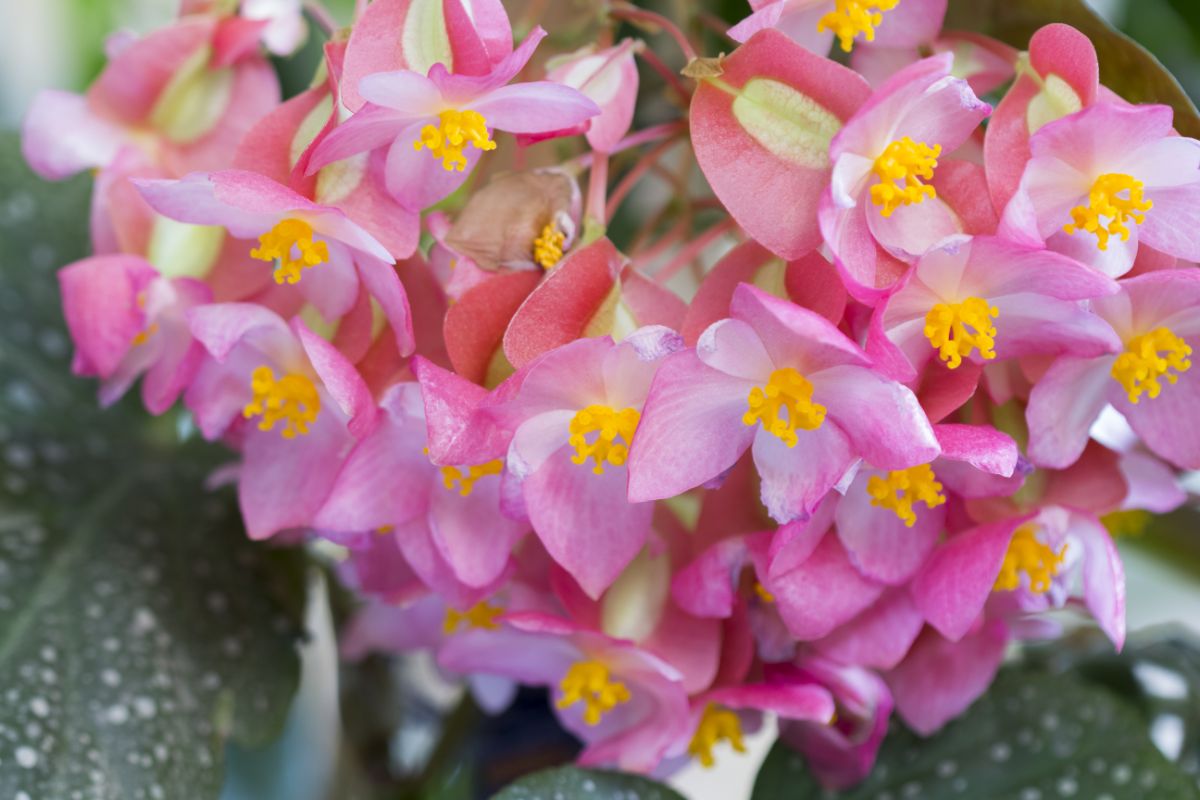
Different begonia varieties have different care requirements, so it’s wise to research the particular type of begonia you’re interested in before you bring your new plant home. However, in general, most begonias grow best in bright, indirect light, and they should be watered regularly. Most begonias will also benefit from added humidity, although some begonias can tolerate average indoor humidity levels.
Most begonias are relatively short-lived houseplants, and they only live for a few years. But you can keep begonia plants going for generations by taking stem cuttings of your plants and propagating them in soil or water.
In general, most indoor begonias should be watered about once every 7 to 10 days, but this can vary depending on the time of the year. A good rule of thumb is to water begonia plants when the top 1 to 2” of soil feels dry to the touch.
Misting can help boost ambient humidity levels around humidity-loving begonia plants, but it’s usually just a quick fix. Most of the time, mist evaporates rapidly, and plants may still develop crispy leaves if you rely on misting alone. To avoid this, try out a humidifier or a pebble tray, which can boost humidity levels around your plants for longer!
Rhizomatous begonias rarely need support, but cane-type begonias will usually need extra support as they grow. Bamboo or moss poles work well for keeping long-stemmed begonia varieties upright. Another option is to prune cane-type begonias at least once a year to keep them from getting too tall.
Most begonias do like higher-than-average humidity levels; however, some begonias are more tolerant of low humidity than others. That said, if you have the space for a humidifier near your begonia collection, you may want to add one. Most types of begonias will grow better with a bit of extra humidity!
Summary
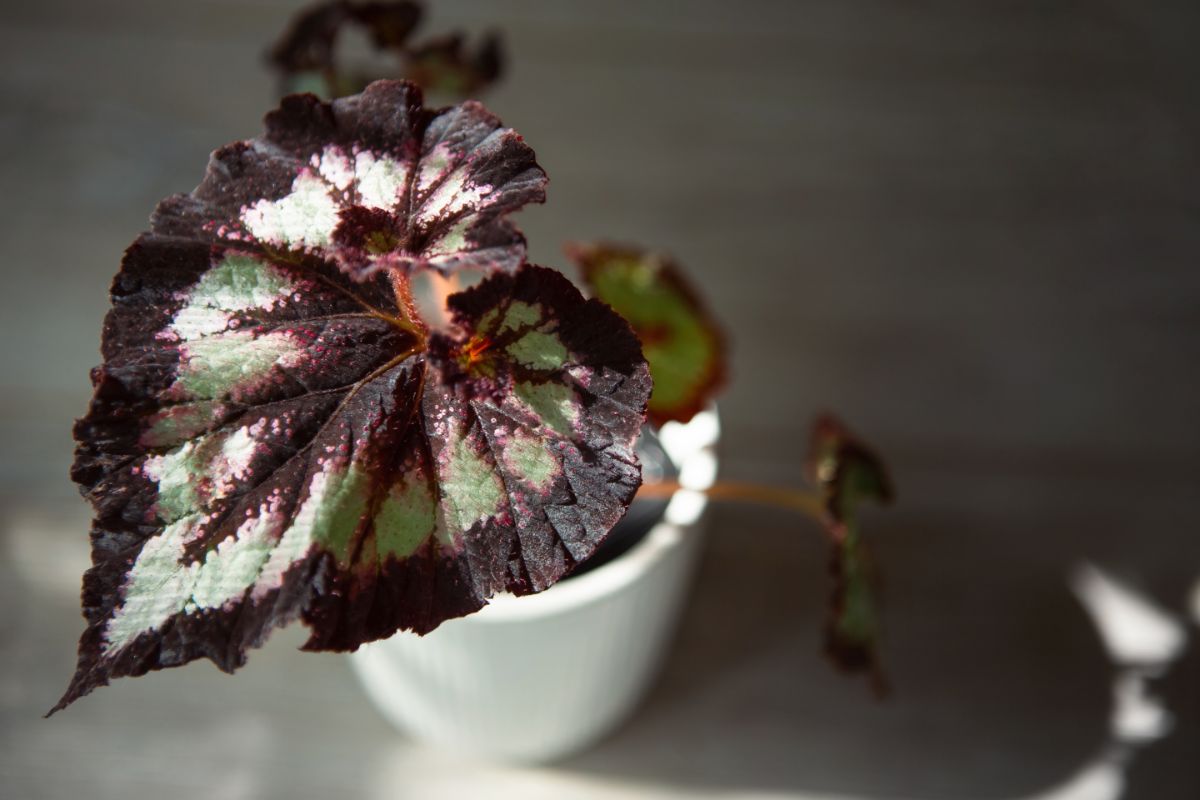
From tall cane begonias to shorter, rex-type begonias, there’s an incredible variety of begonias to choose from. Some begonias make bold statement plants, while other smaller specimens are ideal for hanging baskets and terrarium growing. No matter what begonia variety you choose to grow, begonia plants are certain to enliven your houseplant collection and bring brilliant color into your home every time!
If you love the polka dot begonia and other plants with highly patterned leaves, check out our guide on houseplants with striped leaves and variegated foliage and add even more color to your grow room!

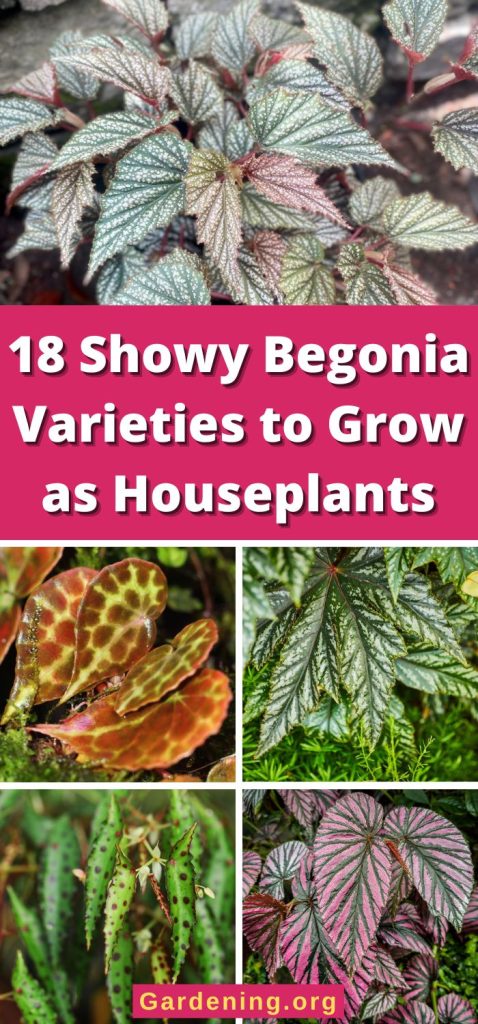
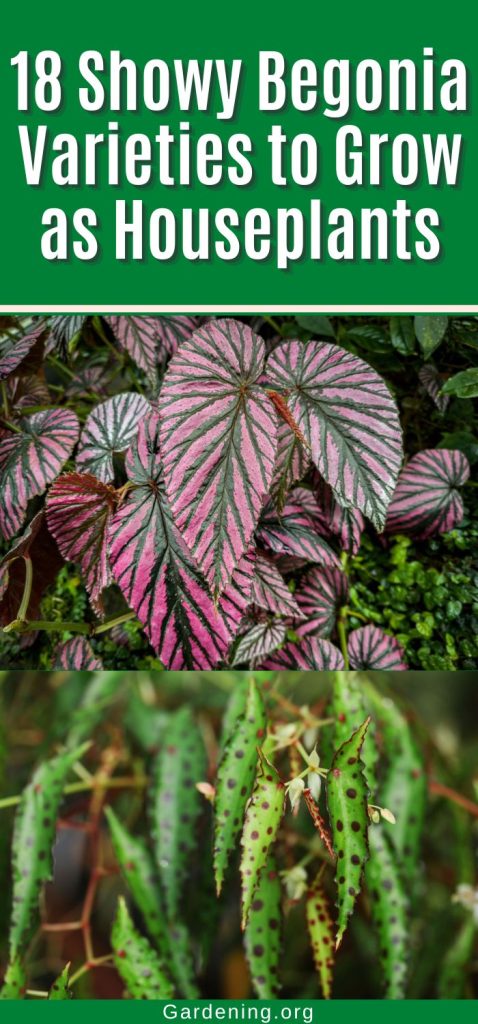
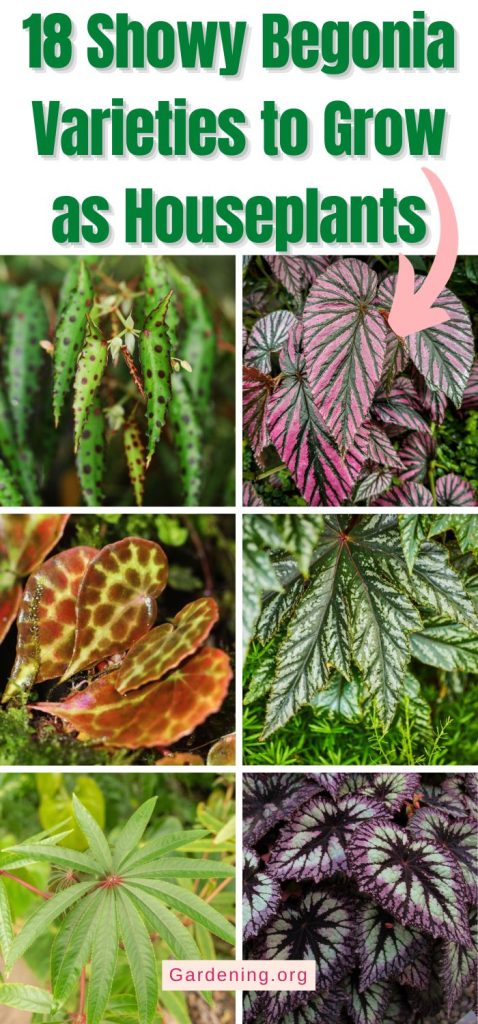
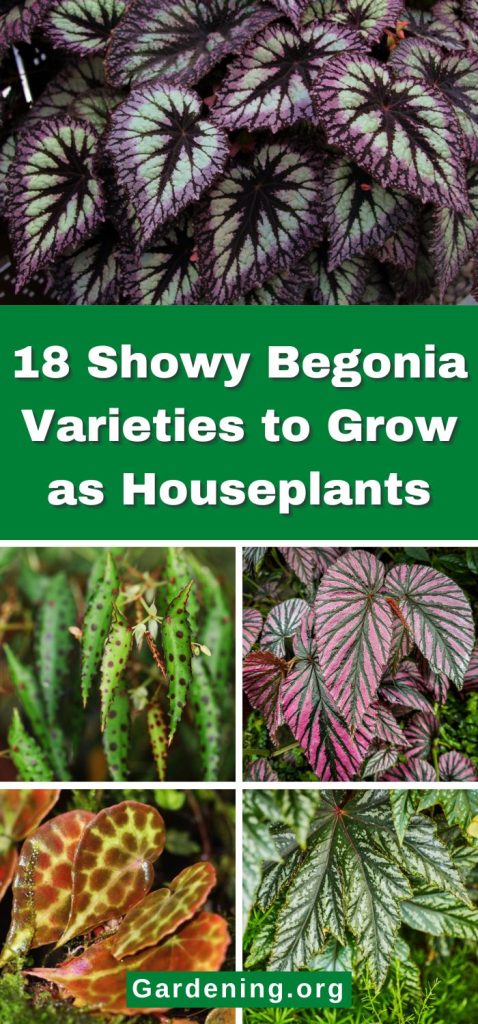
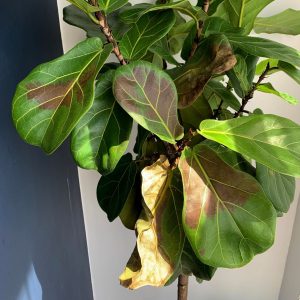
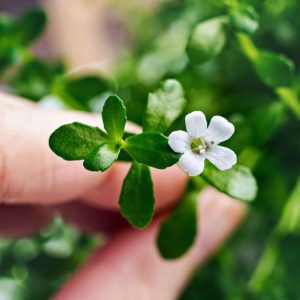
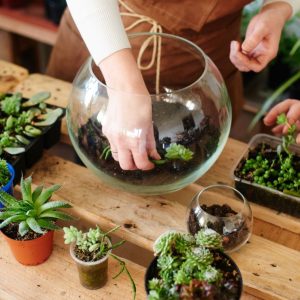
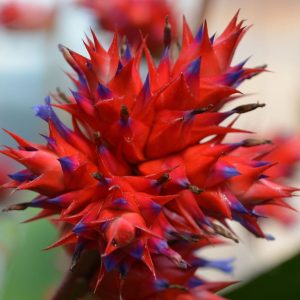
Leave a Reply